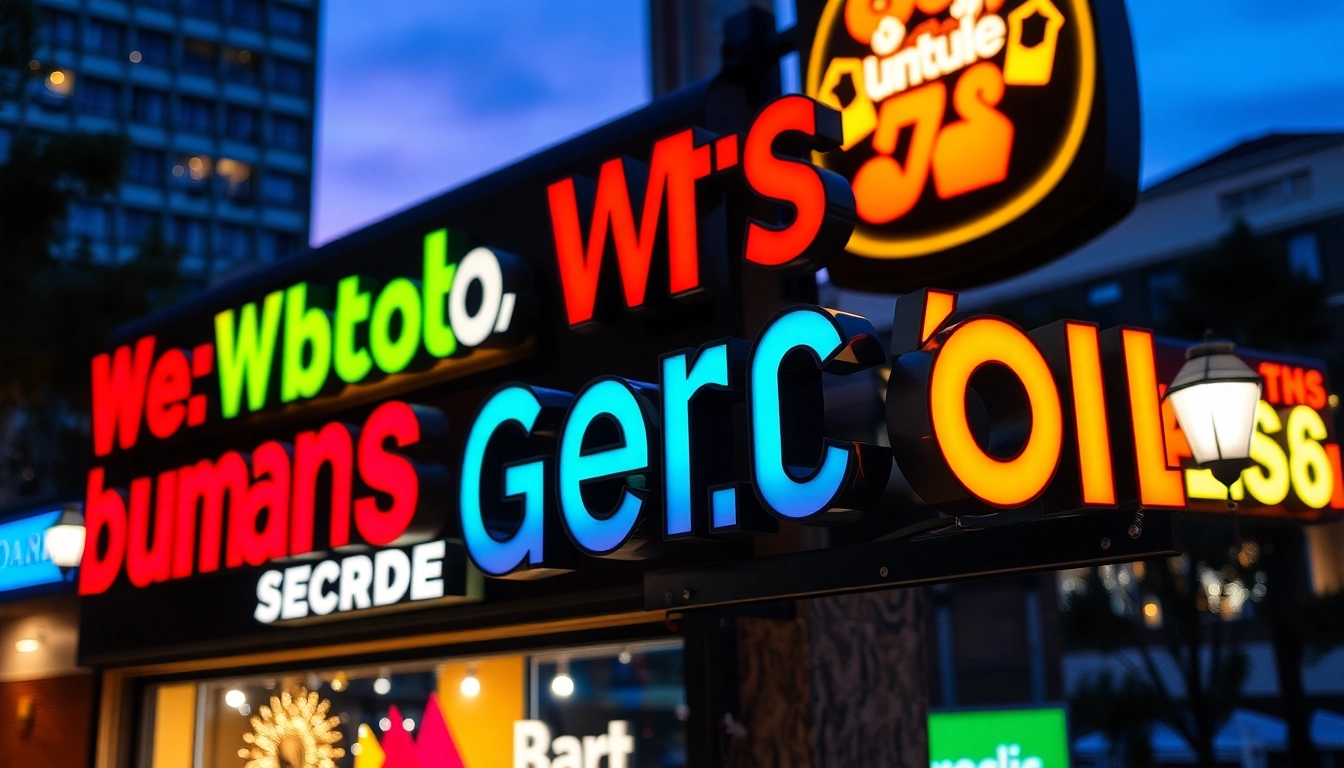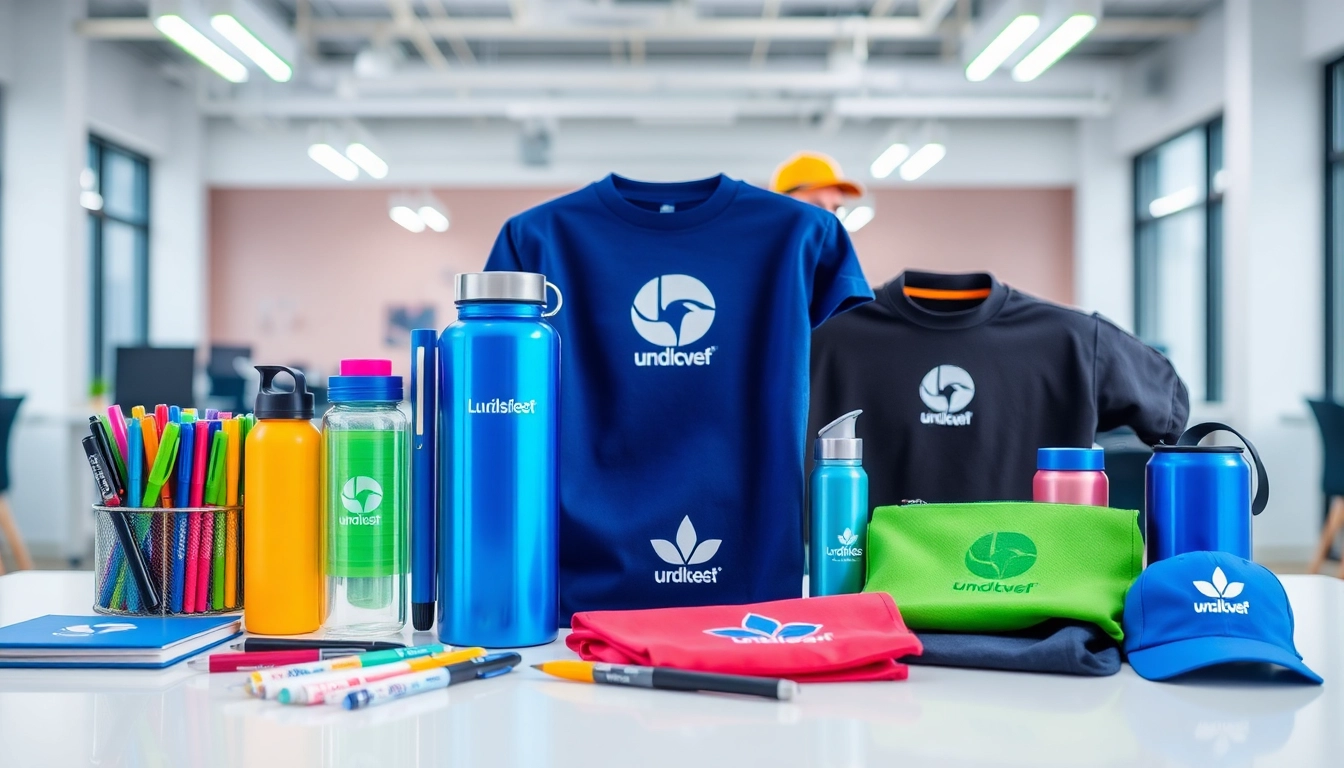Introduction to Custom Signage: Elevating Your Business Presence
In today’s competitive marketplace, standing out is essential for attracting customers, reinforcing your brand, and maximizing business growth. One of the most effective tools for achieving this is through strategic, high-quality custom signs. These tailor-made signage solutions offer flexibility in design, material, and placement, allowing your business to communicate its unique identity clearly and compellingly. Whether you’re a small startup or a large corporation, understanding the various types, materials, costs, and best practices associated with custom signage can vastly improve your marketing efforts and overall aesthetics.
Understanding Custom Signs: Types, Styles, and Materials
Different Types of Custom Signs for Businesses
Custom signs are the backbone of visual branding for any organization. They come in a variety of types, each designed to meet specific objectives, environments, and audiences. Selecting the right type depends on your business goals, budget, and location. Here’s an in-depth look at key customizable signage categories:
- Building Signs: These are prominent signs typically placed on the exterior of your premises, such as channel letters, monument signs, or dimensional logos, forming the first impression of your brand.
- Lighted & LED Signs: Bright, energy-efficient displays for 24/7 visibility, including animated message boards or illuminated letter signs that enhance nighttime presence.
- Safety & ADA Signs: Critical for compliance, these signs include emergency exit indicators, fire safety notices, and ADA-compliant wayfinding signs that prioritize safety and accessibility.
- Outdoor Business Signs: These include storefront banners, canopy signs, and yard signs designed to grab attention from passersby and drive foot traffic.
- Digital & Electronic Signs: Dynamic digital displays allow businesses to change messages in real-time, perfect for promotions, announcements, or event-driven messaging.
- Interior Signs: Wall graphics, window decals, and directional signage that enhance inside customer experience and reinforce your branding.
- Yard & Sidewalk Signs: Portable and economical, these signs are ideal for promoting weekly specials, sales, and local events, increasing curb appeal.
- Banners & Flags: Flexible marketing tools used at events or outside storefronts to attract attention with vibrant visuals.
- Tradeshow Displays & Promotional Signs: Custom displays designed to showcase your brand at industry events, turning abstract booth space into an engaging marketing hub.
Materials Used in Custom Signs: Acrylic, Metal, Vinyl, and Wood
The choice of material significantly influences a sign’s durability, appearance, cost, and suitability for specific environments. Here’s a comprehensive overview:
Acrylic
Popular for its clarity and versatility, acrylic offers sleek, modern aesthetics. It’s ideal for interior displays, window graphics, and illuminated signage due to its light-transmitting qualities. Acrylic signs are easy to fabricate and can be customized into various shapes and thicknesses, providing a polished, professional look.
Aluminum & Metal
Known for durability and strength, aluminum and metal signs are suited for outdoor environments where exposure to weather is inevitable. They resist rust and corrosion, making them perfect for monument signs, pylon signs, or industrial signage. The sleek finish lends a contemporary look, while painted or engraved options add character.
Vinyl
Vinyl is highly adaptable, used extensively for decals, banners, and yard signs. It’s affordable, lightweight, and easy to install. Vinyl signs are great for temporary promotions, along with long-term outdoor use when laminated for weather resistance.
Wood
Offering a rustic or classic appeal, wood signage is often used by boutique shops, restaurants, or businesses aiming for a warm, inviting atmosphere. It can be carved or painted and customized in various finishes. However, it requires maintenance for outdoor durability.
Create Impactful Custom Signs That Drive Business Growth
Design Tips for Eye-Catching Signage
Design is the cornerstone of effective signage. Here are expert tips to ensure your custom signs grab attention and convey your message clearly:
- Simplicity is key: Focus on minimal text and bold visuals to ensure quick comprehension.
- Consistent branding: Incorporate your logo, color palette, and font styles to reinforce brand recognition.
- Contrast and visibility: Use contrasting colors to make text stand out, especially from a distance.
- Typography: Select clear, legible fonts — avoid overly decorative styles for primary messages.
- Call to Action: Clearly direct customers with prompts like “Visit Today,” “Call Now,” or “Shop Online.”
- Navigation considerations: For interior signs, guide customers seamlessly through your space via clear directional signs.
Additionally, leveraging high-resolution graphics and professional layout tools can significantly elevate your signage quality, ensuring it stands out amidst competitors.
Placement Strategies to Maximize Visibility
Even the most beautifully designed sign can fail without proper placement. Strategic positioning increases exposure and impact:
- Main Traffic Routes: Place signs where they are naturally in the line of sight for pedestrians and drivers.
- Height and Elevation: Ensure signs are at eye level or above for maximum visibility, especially outdoors.
- Lighting: Use illuminated signage for nighttime visibility and to emphasize your message.
- Complementary Signage: Pair primary signs with secondary signs like window decals or sidewalk banners for layered messaging.
- Permits and Regulations: Verify local zoning laws and obtain necessary permits for outdoor or high-mounted signage.
Case Study: A retail chain increased foot traffic by 30% after redesigning their outdoor signs for optimal placement and visibility, illustrating the importance of strategic positioning.
Balancing Aesthetics and Functionality in Sign Design
Effective signage combines visual appeal with practical clarity. Prioritize readability and durability without sacrificing style:
- Materials that match environment: Use weatherproof materials for outdoor signs and stylish finishes for interior displays.
- Weather resistance: Incorporate UV coating, anti-fade inks, or laminates for longevity.
- Size appropriateness: Ensure signs are large enough to be read from a distance but proportionate to surroundings.
- Accessibility considerations: Use high-contrast colors and accessible fonts to ensure compliance with ADA standards.
Signs designed with both aesthetics and function in mind foster a professional image while effectively communicating your message.
Cost, Production, and Installation of Custom Signs
Pricing Factors and Budgeting for Custom Signs
Understanding the cost structure of custom signs is vital for setting realistic expectations and making informed decisions. Factors influencing pricing include size, material, complexity, and installation requirements:
- Size: Larger signs generally cost more due to material and fabrication complexity.
- Material: Premium materials like brushed metal or illuminated components increase costs.
- Design Complexity: Intricate logos, custom fonts, or detailed graphics require additional labor and time.
- Lighting & Electronics: LED integrations or animated displays add to the overall expense.
- Installation: Structural considerations, permits, and site conditions impact installation costs.
Average price ranges vary from a few hundred dollars for small yard signs to tens of thousands for large, elaborate outdoor or digital signs. Planning your budget upfront ensures optimal ROI and allows for balancing quality with affordability.
Manufacturing Processes and Turnaround Time
Producing high-quality custom signage involves several steps:
- Design: Concept development and approval, often using digital mockups or prototypes.
- Fabrication: Cutting, printing, engraving, or assembling sign components using CNC machines, digital printers, or handcrafting methods.
- Finishing: Applying protective coatings, lighting, or mounting hardware.
- Quality Control: Inspection and fine-tuning before delivery or installation.
Typical turnaround times range from 3-5 business days for standard signs to 2-4 weeks for custom or large-scale projects, depending on complexity and manufacturer workload. Early planning is crucial for timely launches.
Installation Best Practices for Safety and Durability
Proper installation ensures your sign remains effective and safe over time:
- Structural integrity: Use appropriate mounting hardware and anchors for the environment (e.g., concrete, steel, or wood surfaces).
- Weatherproofing: Seal all connections and surfaces to prevent water ingress or corrosion.
- Accessibility & Safety: Adhere to ADA clearance requirements and ensure signs are securely fastened to prevent accidents.
- Compliance: Obtain necessary permits and have professional installers handle complex electrical or structural elements.
High-quality installation reduces long-term costs by preventing early damage and ensuring compliance with local safety standards.
Compliance and Accessibility: ADA and Safety Signage
Ensuring Your Custom Signs Meet ADA Standards
The Americans with Disabilities Act (ADA) mandates signage that provides equal access for all individuals. ADA-compliant signs must conform to specific criteria:
- Height and Placement: Mounted at accessible heights, typically between 48-60 inches from the floor to the baseline of the mounted sign.
- Contrast and Typeface: Use high-contrast colors and sans-serif fonts for readability.
- Brushed or raised characters: Tactile characters and graphics are required for indoor signs, with a minimum height of 5/8 inches.
- Pictograms and Symbols: Use standardized symbols for restroom, exits, and other critical information.
Designing with accessibility in mind not only ensures compliance but also broadens your audience reach and demonstrates corporate responsibility.
Safety Signage for Emergency and Regulatory Compliance
Beyond ADA signs, safety signage must meet local codes such as OSHA standards. Key considerations include:
- Visibility: Use reflective or illuminated materials for emergency signs.
- Content clarity: Concise language and universally recognized symbols.
- Placement: Strategically position signs near hazards, exits, and safety equipment.
- Durability: Use weatherproof and vandal-resistant materials for outdoor safety signs.
Effectively designed safety signage minimizes risks and ensures swift evacuation or response during emergencies.
Material and Design Tips for Long-Lasting Safety Signs
Durability is critical for safety signs exposed to environmental elements. Recommendations include:
- Using high-grade aluminum, or UV-protected vinyl for outdoor safety signs.
- Incorporating anti-glare coatings for readability in various lighting conditions.
- Regular maintenance and inspections to replace faded or damaged signs.
Digital and Innovative Signage Solutions
Integrating LED and Digital Displays with Custom Signs
Digital signage is revolutionizing the way businesses communicate. LED displays and electronic message centers support dynamic content updates, which can include promotions, announcements, and personalized messaging. Advantages include:
- Real-time updates for promotions, menus, or event information.
- Enhanced visibility through vibrant colors and animations.
- Cost-effective advertising by replacing static signage with digital content.
Integrating these technologies with traditional custom signs can dramatically boost engagement and attract more foot traffic.
Interactive and Smart Signage Technologies
Emerging trends include touch-screen displays, QR code integrations, and NFC-enabled signs, allowing customers to interact directly. These technologies facilitate personalized experiences, gather customer data, and foster engagement.
Implementation requires careful planning of hardware, connectivity, and content management systems but offers unparalleled marketing flexibility.
Future Trends in Custom Signage and Digital Branding
The future of signage is moving toward augmented reality, AI-driven content optimization, and eco-friendly digital displays. These innovations aim to create immersive brand experiences, improve message targeting, and reduce environmental impact.
Conclusion: Crafting a Signage Strategy for Success
Investing in the right custom signs is a strategic move to elevate your brand, communicate effectively, and attract clients. From selecting the appropriate types and materials to ensuring compliance and embracing digital innovations, each element plays a crucial role in your overall signage success.
Through thorough planning, expert design, and professional installation, your signage can transform your physical space into a powerful marketing asset. Remember, signage is not just about visibility; it’s about creating memorable impressions that foster customer loyalty and drive revenue.
Contact us today at (502) 235-4063 to learn how we can help craft a comprehensive signage solution tailored to your business needs. Let us help you make your message stand out in the crowd and turn viewers into loyal customers.


